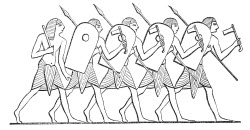Ancient Egyptian Soldiers Who Helped Build The Pyramids
|
While as young students learning about the early development of civilization we learned about the Egyptians who possessed great architectural minds to be able to architect and construct the Great Egyptian Pyramids. Travelers arrive from all different corners of the world to gaze upon these immense structures and for many years now they have permanently positioned themselves as one of the Seven Wonders of the World. We were taught to believe that the Pharaohs of the time forced tens of thousands and even hundreds of thousands of his people into slavery to complete these pyramids only for their own personal gain. Although the Egyptian pyramids did require incredible feats of human laborers, but it was a lot more human ingenuity involved. The teachers taught us to think that the pyramids were all constructed by slaves. However, the pyramids were designed by brilliant mathematicians and architects and the laborers were mostly recruited from all over the country. Think of it as a required military draft and every man was required to serve his country and his pharaoh by committing to national services. These were in essence the Egyptian soldiers who were responsible in constructing the great pyramids.
|
Most of the recruited workforce for the pyramids consisted of farmers, haulers, quarry men, skilled masons, men who positioned the blocks, food caterers, managerial officials who supervised the construction. That was in addition to the math scholars and professional architects were responsible for the four side pyramid design. In the entire workforce was estimated to be around 20,000 to 30,000 workers at any given time. During the pyramid construction the workforce would be contracted to come work from a period of a few months to occasionally a few years. It was easy to say that the pyramids needed close to half a million workers to work on both the inside and outside because the immense size of the pyramids make the numbers appear valid. However, during that period of the main pyramid construction the population of Egypt was barely 1.5 million people so to have one-third of the population assigned to constructing a single pyramid does not make sense. The question of how many workers were required to construct the Great Pyramid at Giza remains unanswered, but as more research is done and more knowledge is uncovered the total figure of workers goes down. Since the area of where the pyramids were built did not span a large area if there were 36,000 workers employed it would have been very difficult logistically to complete this project.
When these Egyptian soldiers or workers from the outer lying rural areas were commissioned to perform their national service, the pharaoh would have a temporary village constructed to house all the workers near the pyramid construction site. The workers would remain to work out their term before they could return back to their village. The workers were all fed by the hired caterers. There is still evidence of these villages near the pyramid sites that were previously uncovered. It was in the best interest to ensure the workforce was taken care since so much of the construction involved labored work. There was no advanced technology at the time that would easily allow the carved stoned to be brought from the quarry to the construction site other pulling them with human power.
The Great Pyramid of Khufu would have required roughly a workforce of 30,000 people to construct made by a consensus of Egyptologists. As each layer of the pyramid was laid out and the pyramid grew in height it would have subsequently required fewer workers. It is also known that a lot of the earlier pyramids and the ones build after the Great Pyramid could be completed with a smaller workforce because they were smaller and the slope was gentler. In addition some of the pyramids like Khufu employed the use of mud brick materials to fill the core requiring less labor to do. The pyramids required a lot of human ingenuity, strong sense of collaboration, and a nation of people committed to their pharaoh. As a result the Egyptians were able to construct these immense structures that stood the test of time and allowed this generation the opportunity to gaze upon their greatness.
More Articles :

|
